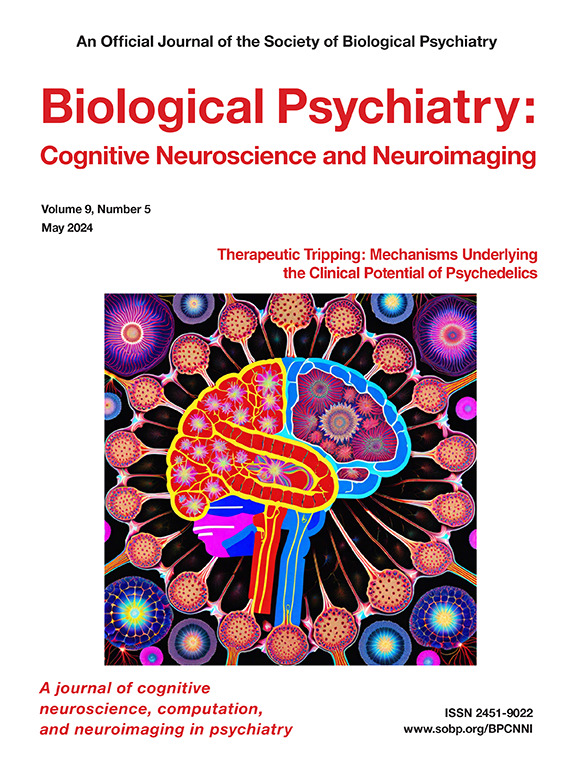Spatiotemporal Eye Movement Dynamics Reveal Altered Face Prioritization in Early Visual Processing Among Autistic Children
IF 5.7
2区 医学
Q1 NEUROSCIENCES
Biological Psychiatry-Cognitive Neuroscience and Neuroimaging
Pub Date : 2025-01-01
DOI:10.1016/j.bpsc.2024.08.017
引用次数: 0
Abstract
Background
Reduced social attention—looking at faces—is one of the most common manifestations of social difficulty in autism that is central to social development. Although reduced social attention is well characterized in autism, qualitative differences in how social attention unfolds across time remains unknown.
Methods
We used a computational modeling (i.e., hidden Markov modeling) approach to assess and compare the spatiotemporal dynamics of social attention in a large, well-characterized sample of children with autism (n = 280) and neurotypical children (n = 119) (ages 6–11) who completed 3 social eye-tracking assays at 3 longitudinal time points (baseline, 6 weeks, 24 weeks).
Results
Our analysis supported the existence of 2 common eye movement patterns that emerged across 3 eye-tracking assays. A focused pattern was characterized by small face regions of interest, which had high a probability of capturing fixations early in visual processing. In contrast, an exploratory pattern was characterized by larger face regions of interest, with a lower initial probability of fixation and more nonsocial regions of interest. In the context of social perception, children with autism showed significantly more exploratory eye movement patterns than neurotypical children across all social perception assays and all 3 longitudinal time points. Eye movement patterns were associated with clinical features of autism, including adaptive function, face recognition, and autism symptom severity.
Conclusions
Decreased likelihood of precisely looking at faces early in social visual processing may be an important feature of autism that is associated with autism-related symptomology and may reflect less visual sensitivity to face information.
时空眼动动力学揭示了自闭症儿童早期视觉处理中面部优先性的改变。
背景:自闭症患者最常见的社交障碍表现之一就是社交注意力(看脸)减退。虽然自闭症患者的社交注意力减退已被充分描述,但社交注意力在不同时期的定性差异仍是未知数:我们使用计算建模(即隐马尔可夫建模)方法评估并比较了自闭症儿童(n = 280)和神经典型儿童(n = 120)(6-11 岁)社交注意力的时空动态:我们的分析结果表明,在三种 ET 测验中存在两种常见的眼动模式。聚焦模式的特点是感兴趣的面部区域较小,在视觉处理的早期捕捉到定点的概率较高。与此相反,探索型模式的特点是感兴趣的面部区域较大,最初定格的概率较低,而且非社会感兴趣的区域较多。在社交感知方面,自闭症儿童在所有社交感知测试和所有三个纵向时间点上都表现出明显多于神经畸形儿童的探索性眼动模式。眼动模式与自闭症的临床特征有关,包括适应功能、人脸识别和自闭症症状严重程度:结论:自闭症儿童在社交视觉处理早期精确注视人脸的可能性降低,这可能是自闭症的一个重要特征,与自闭症相关症状有关,并可能反映出他们对人脸信息的视觉敏感度较低。
本文章由计算机程序翻译,如有差异,请以英文原文为准。
求助全文
约1分钟内获得全文
求助全文
来源期刊

Biological Psychiatry-Cognitive Neuroscience and Neuroimaging
Neuroscience-Biological Psychiatry
CiteScore
10.40
自引率
1.70%
发文量
247
审稿时长
30 days
期刊介绍:
Biological Psychiatry: Cognitive Neuroscience and Neuroimaging is an official journal of the Society for Biological Psychiatry, whose purpose is to promote excellence in scientific research and education in fields that investigate the nature, causes, mechanisms, and treatments of disorders of thought, emotion, or behavior. In accord with this mission, this peer-reviewed, rapid-publication, international journal focuses on studies using the tools and constructs of cognitive neuroscience, including the full range of non-invasive neuroimaging and human extra- and intracranial physiological recording methodologies. It publishes both basic and clinical studies, including those that incorporate genetic data, pharmacological challenges, and computational modeling approaches. The journal publishes novel results of original research which represent an important new lead or significant impact on the field. Reviews and commentaries that focus on topics of current research and interest are also encouraged.
 求助内容:
求助内容: 应助结果提醒方式:
应助结果提醒方式:


